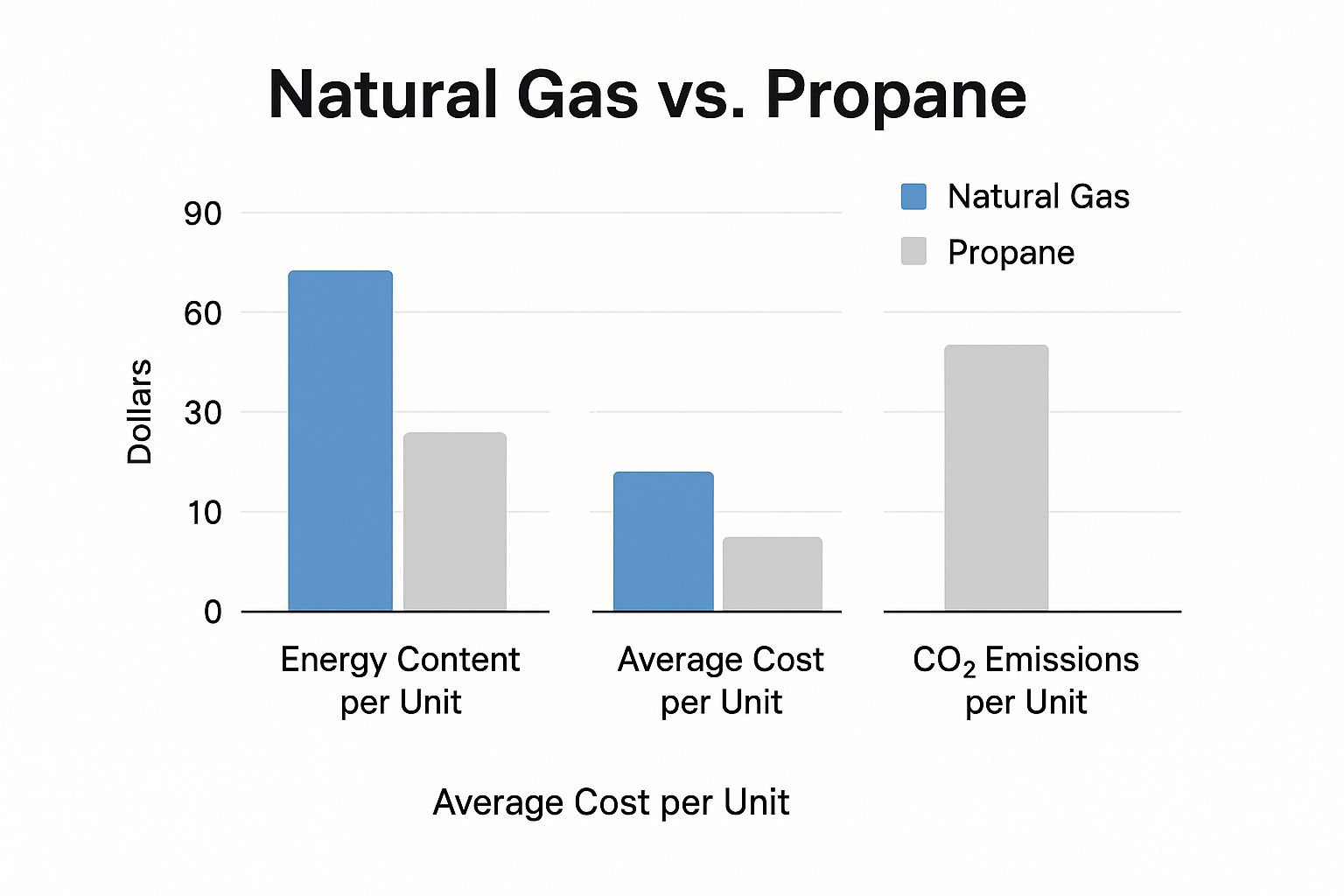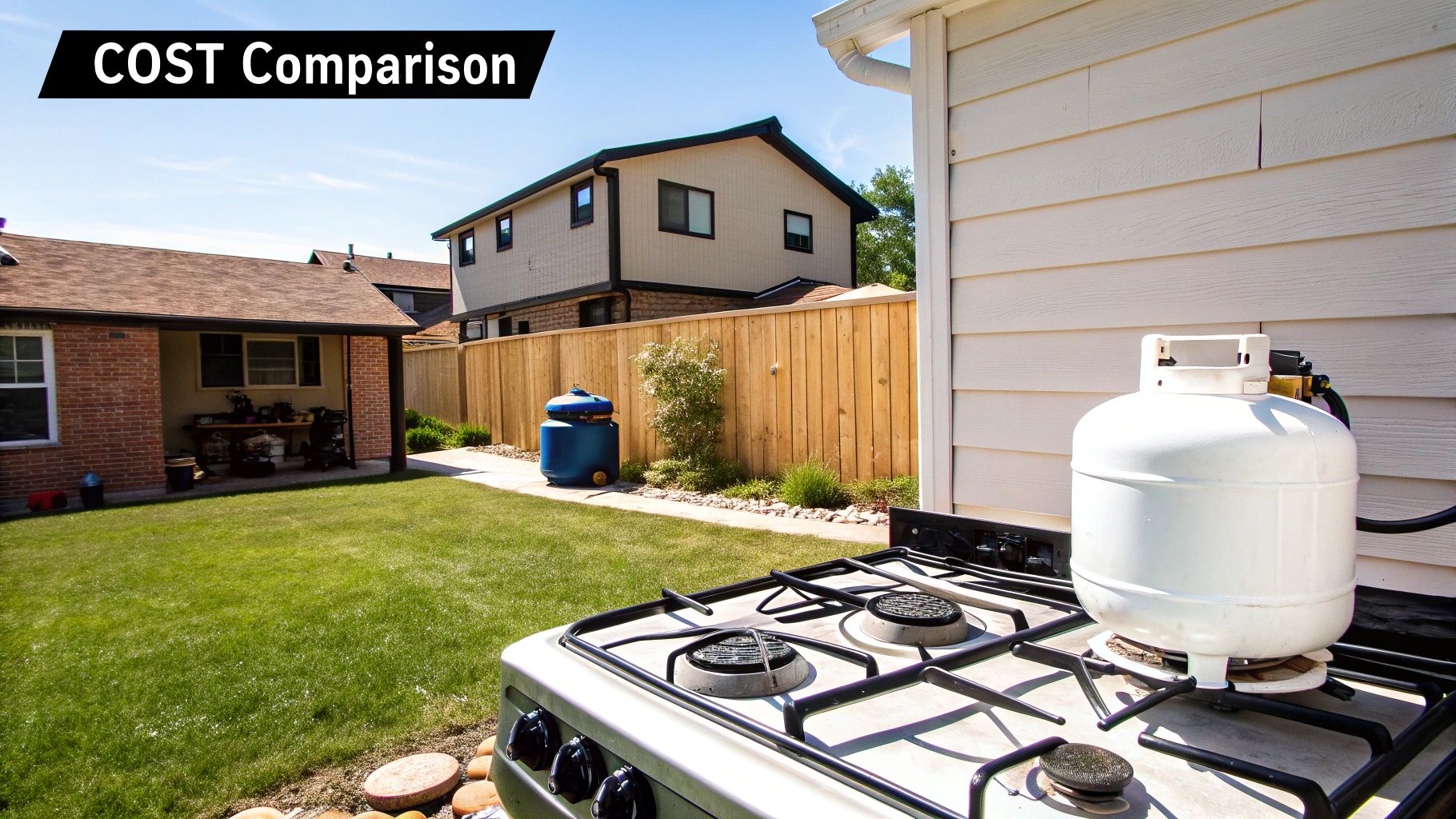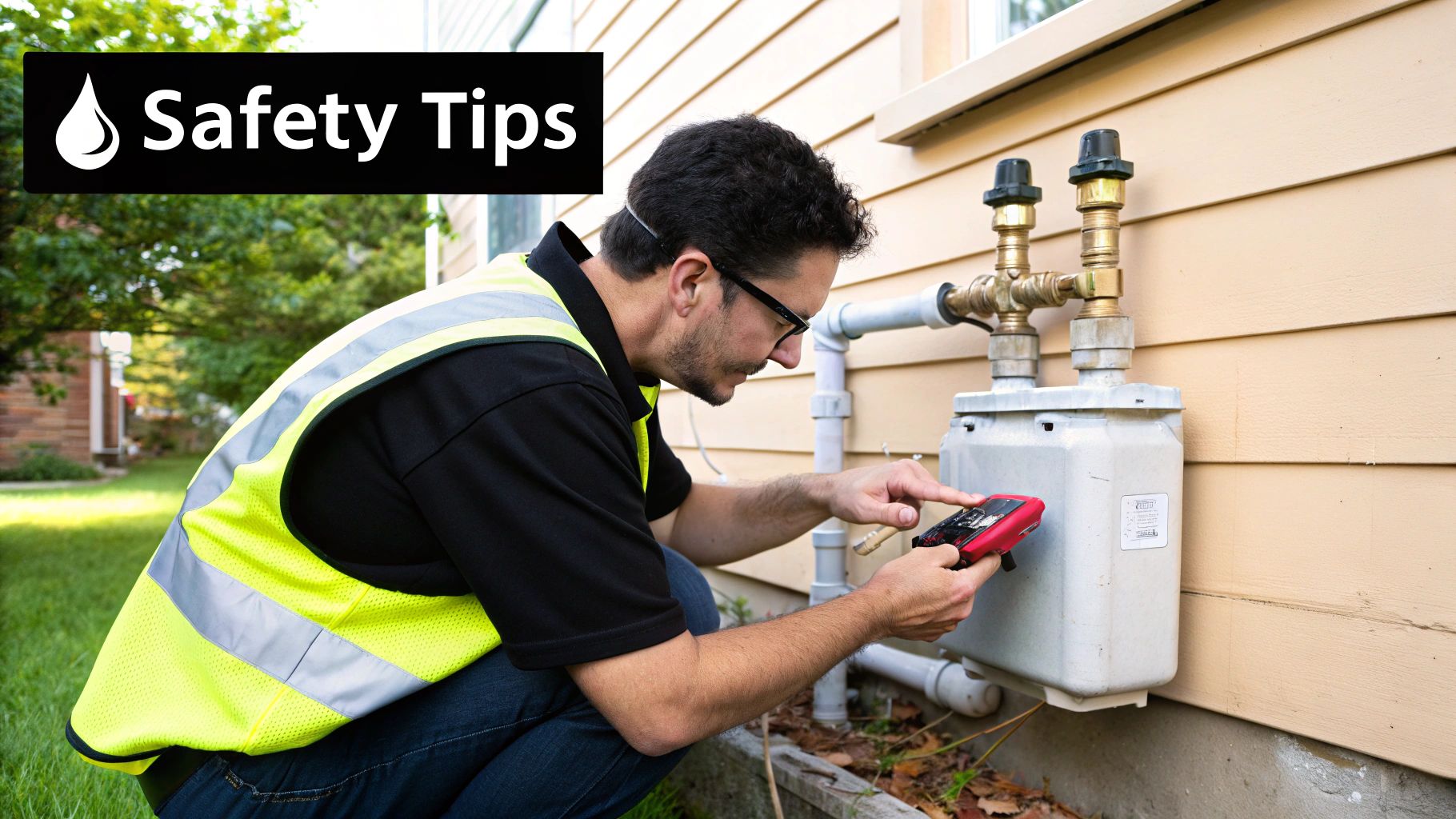
Natural Gas vs Propane for Commercial Griddles
When it comes to the natural gas vs propane debate for your commercial griddle, the decision really boils down to one key difference: infrastructure versus portability.
Think of it this way: natural gas gives you a continuous, steady stream of low-cost fuel through a fixed utility line. It's the go-to for stationary restaurants. Propane, on the other hand, is all about high-energy, portable power delivered in tanks, making it the champion for food trucks and off-grid setups. The right choice isn't about which fuel is better overall, but which one fits your commercial kitchen like a glove.
Choosing Your Commercial Griddle's Fuel Source
Picking the right fuel for your commercial griddle is one of those foundational decisions that echoes through your daily operations, affecting everything from your utility bills to your kitchen's workflow. It’s less about finding a single "best" fuel and more about aligning your equipment with your specific business model. Your location, your access to utility lines, and whether you need to be mobile will steer you toward the right answer.
A busy diner in the heart of the city, for example, is almost always better off with a direct gas line hookup. But if you're running a food truck that needs to serve customers anywhere, you need a self-contained power source. Understanding these core scenarios is the first step in setting up your kitchen for maximum efficiency and profit. Great manufacturers like Atosa get this, engineering top-tier griddles that work beautifully with either fuel, so you never have to sacrifice quality for convenience.
Natural Gas vs Propane At a Glance
To make the right call, it helps to see how these two fuels stack up side-by-side. Here's a quick rundown of the main differences you'll want to consider for your commercial griddle.
| Factor | Natural Gas | Propane |
|---|---|---|
| Energy Output | Lower BTUs per unit | Higher BTUs per unit (~2.5x more) |
| Cost Structure | Priced per therm/cubic foot | Priced per gallon |
| Portability | Stationary (requires a pipeline) | Highly portable (stored in tanks) |
| Installation | Requires professional plumbing | Simpler setup with tanks |
This table gives you the high-level view, but the visual data below really drives the point home.

As you can see, propane packs a bigger energy punch per unit, but that power often comes with a higher price tag. This creates a classic trade-off: do you prioritize raw power and flexibility, or do you focus on lower long-term operating costs for your commercial kitchen?
If you have access to a utility line, exploring the full range of available natural gas griddle options is a smart move when planning your kitchen layout.
Comparing Heat Output and Performance

When the ticket machine won't quit during a Saturday morning rush, the only thing that matters is how much your commercial griddle can handle. The heart of the natural gas vs. propane discussion almost always lands on heat output, which we measure in British Thermal Units (BTUs). It’s a simple metric: one BTU is the energy it takes to heat one pound of water by one degree Fahrenheit.
If you just look at the raw numbers, propane looks like the heavyweight champion. It packs a serious punch, delivering about 2,500 BTUs per cubic foot. Natural gas comes in at around 1,030 BTUs. That massive difference on paper suggests propane griddles should heat up faster and hit those high searing temps with ease, a huge plus for slinging burgers or steaks.
But here’s the thing: a commercial griddle’s real-world power isn’t just about the fuel. It's about how the griddle is built to use that fuel. This is where smart engineering and burner design completely change the game.
How Burner Design Closes the Gap
Don't mistake a modern natural gas commercial griddle for an underperformer. Top-tier manufacturers like Atosa have poured a ton of R&D into high-efficiency burners that squeeze every last bit of power from the available BTUs. These advanced systems deliver strong, even heat across the entire cooktop, wiping out the dreaded hot and cold spots that can tank food quality.
So what does that mean in a real kitchen? It means a well-built Atosa natural gas griddle can go toe-to-toe with a propane model, even when you're slammed. Imagine a 48-inch flat top loaded end-to-end with pancakes and bacon; that requires steady, unwavering heat. An efficient Atosa natural gas unit will hold its temperature just as reliably as its propane cousin, giving you consistent results, plate after plate.
Key Insight: Propane has more energy on paper, but a griddle’s burner efficiency is what dictates its actual performance. A high-quality Atosa natural gas griddle delivers the same cooking power and consistency you’d expect from propane.
Performance in Real-World Scenarios
The right choice really boils down to your menu and how your kitchen operates day-to-day. Let's look at a few common situations for commercial griddles:
- Need for Speed: A food truck pulling up to a lunch spot needs to get hot and start serving now. Propane’s higher BTU count gives it a slight head start here, cutting down preheat time between stops.
- The Long Haul: Think of a busy diner that runs from sunup to sundown. In this case, an Atosa natural gas griddle hooked up to a main utility line is a workhorse, providing a dependable and affordable heat source that simply never runs out.
- Finesse and Control: For delicate foods like fish or perfectly cooked eggs, even heat distribution is far more important than raw power. Both Atosa natural gas and propane griddles are engineered for this kind of precise control, making the fuel source less of an issue than the quality of the griddle itself.
At the end of the day, either fuel can power a high-performance commercial kitchen. The most important decision is investing in a griddle that’s built to make the most of your chosen fuel source. Atosa designs their equipment so that whether you’re on a gas line or running off tanks, you’re always ready for the rush.
Analyzing Your Long-Term Operating Costs
When you're running a commercial kitchen, the sticker price on a new griddle is just the beginning. The real cost shows up on your monthly utility bills, and that’s where the natural gas vs propane decision really hits your bottom line.
For most brick-and-mortar restaurants, natural gas is the undisputed king of cost-efficiency. It’s piped directly to your kitchen by a utility company and you’re billed for what you use, usually per therm or cubic foot. This setup gives you a steady, predictable, and almost always cheaper fuel source—perfect for a busy diner firing up the griddle from open to close.
The Propane Pricing Model
Propane plays by a different set of rules. You buy it by the gallon in tanks that you keep on-site, which introduces a few moving parts to your budget. You’ve got the fuel cost, but you also have to think about tank rental fees and delivery charges. This makes it a bit of a premium option, best reserved for situations where a permanent gas line just isn't in the cards.
The biggest thing to watch with propane is price swings. The cost can jump around quite a bit depending on market demand, especially during different seasons. Since it's a popular home heating fuel, you can bet the price will spike when a cold snap hits.
Take January 2025, for example. U.S. propane consumption shot up to 1.48 million barrels per day—the highest January level in 18 years—all because of the coldest weather since 2014. A surge like that directly impacts what you pay to fuel your griddle. You can dig into more of this data over at the U.S. Energy Information Administration.
Calculating Your True Cost
To figure out what you'll really be spending, you need to look at the whole picture, not just the per-unit price of the fuel. Here’s what to weigh:
- Fuel Consumption: Is your commercial griddle going to be running all day, every day? For high-volume kitchens, the small cost difference between the fuels adds up fast.
- Infrastructure Costs: Getting a natural gas line installed is a one-time, professional job with a significant upfront cost. Propane skips this but might stick you with ongoing tank rental fees.
- Delivery and Fees: Does your local propane supplier charge for refills? Those delivery fees are a recurring operational expense you need to factor in.
- Equipment Efficiency: A top-tier griddle, like the ones from Atosa, is built to squeeze every bit of energy out of your fuel, whether it’s natural gas or propane. A more efficient unit means lower consumption and smaller bills, period.
While natural gas usually wins the race on daily running costs for a stationary kitchen, propane’s value is its freedom. For food trucks, catering gigs, or off-grid events, that portability is everything. By weighing these factors honestly, you can see which fuel actually makes the most financial sense for your specific commercial griddle.
Understanding Installation and Infrastructure Needs
Let’s be honest. As much as we weigh the performance and running costs of a commercial griddle, the choice between natural gas and propane often boils down to one simple, unavoidable question: what can your building actually support? Your kitchen's current setup is usually the single biggest factor, shaping everything from your initial investment to how complicated the installation will be.
Hooking up a natural gas griddle is a serious utility job. It needs a direct, permanent connection to a municipal gas line, and this is non-negotiable work for a licensed plumber. We're not just talking about a recommendation here; it's a hard requirement based on strict building codes designed to keep everyone safe. If you don't already have a gas line in your kitchen, the upfront cost can be steep, but the payoff is the sheer convenience of a fuel supply that simply never runs out.
The Propane Approach: Portability and Planning
Propane offers a totally different experience, one that’s all about flexibility. Because the fuel is stored right on-site in tanks, you get to skip all the complex plumbing and utility hookups. This makes the setup process much faster and easier—a huge win for food trucks, caterers, or any kitchen located where gas lines just aren't an option.
Of course, that portability comes with its own to-do list. You are now the fuel manager. This means setting up a regular refill schedule with a local supplier and keeping a close eye on your supply. Running out of propane in the middle of a dinner rush isn’t just an inconvenience; it’s a disaster. Good inventory management becomes a crucial part of your daily routine.
Key Consideration: Local fire and safety codes are extremely specific about where you can place propane tanks. They dictate minimum distances from buildings, ignition sources, and property lines, which could easily affect your kitchen layout and where you can store your fuel.
Comparing Installation Realities: Atosa Griddles
To make this crystal clear, let's look at what it takes to set up an Atosa griddle with each fuel type. You'll see right away how different the starting line is for each.
| Aspect | Natural Gas Installation | Propane Installation |
|---|---|---|
| Connection Type | Permanent, fixed pipeline connection. | Flexible hoses connected to portable tanks. |
| Professional Help | Mandatory: Licensed plumber for hookup. | Recommended: Professional for initial setup. |
| Upfront Cost | Potentially high due to plumbing work. | Lower, mainly tied to tank purchase/rental. |
| Flexibility | Stationary; the griddle stays put. | Highly mobile; ideal for food trucks/events. |
At the end of the day, your location is the deciding vote. A restaurant in a downtown building is almost certainly going to go with a natural gas hookup. On the other hand, a food truck or a caterer popping up at a weekend market will need the self-contained power of a propane griddle. Atosa builds its equipment to perform brilliantly in both environments, so you can be confident you're getting top-tier power no matter what your infrastructure looks like.
How Atosa Griddles Deliver for Both Fuel Types

Worrying about natural gas versus propane can feel like a huge decision, but the truth is, a top-tier commercial griddle is built to master both. Atosa gets that every kitchen is different, so they engineer their commercial griddles for powerful, steady performance no matter what's fueling them. It’s less about the gas and more about the quality of the machine.
Atosa griddles are built like tanks, with heavy-duty stainless steel bodies and thick, polished steel cooktops that hold and spread heat incredibly well. For instance, Atosa’s propane and natural gas griddles feature burners that provide 30,000 BTUs each, ensuring consistent high heat regardless of the gas type. This smart engineering closes the performance gap you might expect between higher-BTU propane and budget-friendly natural gas.
The Power of Built-In Flexibility
One of the smartest features you'll find in all Atosa gas griddles is the included conversion kit. This small package is a huge deal, letting a certified technician switch the griddle from its factory fuel setting (usually natural gas) to propane, or vice versa. This adaptability is a lifesaver for any growing business.
Think about it: you could open your restaurant in a spot with a natural gas line. But if you move to a new building without one or decide to launch a food truck, that same reliable Atosa griddle can be converted to run on propane tanks. You just saved yourself the cost of buying a whole new piece of equipment.
This forward-thinking design gives you incredible operational freedom. Your investment in an Atosa griddle is safe from future changes, whether that means a new location, a pivot into mobile catering, or just reacting to local fuel prices.
Ensuring Consistent Cooking Results
At the end of the day, what matters is churning out perfectly cooked food, service after service. Atosa makes sure its propane and natural gas griddles deliver that same consistency.
- Precise Thermostatic Controls: Chefs can dial in and hold exact temperatures, which is critical for everything from delicate pancakes to getting a hard sear on a burger.
- Rapid Recovery Times: The powerful burners and thick steel plates work together to get the griddle back up to temp fast, even after you load it with cold ingredients. This keeps the line moving during your busiest rushes.
This focus on core cooking performance means you can pick your fuel based on what makes sense for your budget and location, without ever having to compromise on quality. You can browse a huge selection of Atosa griddles and other models to find the perfect match for your kitchen's setup and your menu's needs. The engineering makes sure the food that comes off the flattop is always first-rate.
Navigating Safety and Environmental Factors

In any professional kitchen, safety is everything. It's the bedrock of your operation. When you're choosing between natural gas and propane for your commercial griddle, you absolutely have to understand the safety rules and environmental footprint of each one.
Both fuels are incredibly safe when you follow the rules, but their physical properties are different, and that means different safety procedures. Natural gas is a global powerhouse, and its massive scale speaks to its reliability. In 2023 alone, global consumption reached about 4,072 billion cubic meters, a testament to how much it's trusted in commercial kitchens worldwide. You can dig into more of this data on global gas markets from the International Energy Agency.
Key Safety Protocols for Each Fuel
Natural gas is lighter than air. That's a key detail. If there's a leak, the gas rises and disperses upwards. To make sure you'd notice it immediately, utility companies add a sulfur-based compound called mercaptan, which gives it that unmistakable "rotten egg" smell. The single most important safety step is having a licensed pro handle the installation to ensure every connection is tight and up to code.
Propane is the opposite—it’s heavier than air. This means a leak can cause gas to pool in low spots, creating a serious fire risk. Because of this, how you handle and store propane tanks is critical.
- Secure Storage: Tanks must always be stored upright in a well-ventilated spot, far from any ignition source or building exit.
- Regular Inspections: Make it a habit to check hoses and connections for cracks, wear, or any damage that could cause a leak.
- Professional Handling: Only trained staff or a certified professional should be connecting and disconnecting propane tanks. No exceptions.
Crucial Takeaway: The biggest safety difference comes down to gas density. Natural gas rises and scatters, while propane sinks and pools. Both demand professional installation and strict adherence to codes, but propane requires extra vigilance with tank storage and leak detection in low-lying areas.
A Clearer Look at Environmental Impact
The environmental debate between natural gas vs propane isn't as simple as it seems for commercial griddles. Sure, both are fossil fuels that burn cleaner than coal or oil, but you have to look at the whole picture.
At the point of use, propane is often seen as a slightly cleaner-burning fuel, creating fewer emissions. The catch with natural gas comes from its production and transport, which can lead to methane leaks. Methane is a potent greenhouse gas, and these "fugitive emissions" are a real environmental concern.
Ultimately, either fuel is a huge improvement over older energy sources. By choosing a high-efficiency Atosa griddle, you're already ensuring you use as little fuel as possible, which minimizes your kitchen's environmental footprint no matter which gas you pick.
Wrapping Up: Your Final Questions Answered
Even after comparing natural gas and propane for commercial griddles, you might have a few lingering questions. Let's tackle some of the most common ones we hear from kitchen owners before they make a final decision.
Can I Convert an Atosa Griddle Myself?
This is a big one. While every Atosa gas griddle includes a conversion kit, this is strictly a job for a licensed technician. Don't be tempted to DIY this one.
Improperly converting a griddle isn't just dangerous; it can lead to poor performance and will absolutely void your warranty. A pro knows exactly how to adjust the orifices and pressure regulator to guarantee your unit runs safely and efficiently on the new fuel.
Which Fuel Is Better for a Food Truck?
For any mobile kitchen, propane is the only realistic option. There's just no way to hook up to a natural gas line when you're on the move.
Propane tanks give you the powerful, portable heat source you need to keep up in a fast-paced environment. Atosa has a solid lineup of heavy-duty propane griddles that are built for the road.
Final Takeaway: At the end of the day, the food won't know the difference. A high-quality griddle is engineered to cook consistently whether it's hooked up to a gas line or a propane tank. Your decision really boils down to logistics and cost, not culinary results.
Does the Fuel Type Change How Food Cooks?
Nope. As long as your commercial griddle is properly calibrated, the finished product will be identical.
The main difference is in the heat delivery. Propane packs a bit more of a punch with its higher BTU content, so it might get your griddle up to temperature a few moments faster. But once it's hot, a quality natural gas griddle from a brand like Atosa holds that heat just as steady for reliable, even cooking.
Ready to find the perfect commercial griddle that delivers the performance and reliability your kitchen demands? Explore our full range of commercial griddles at Griddles.com. Check out the selection and find your perfect match today at https://griddles.com.
